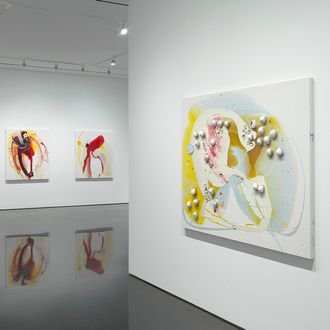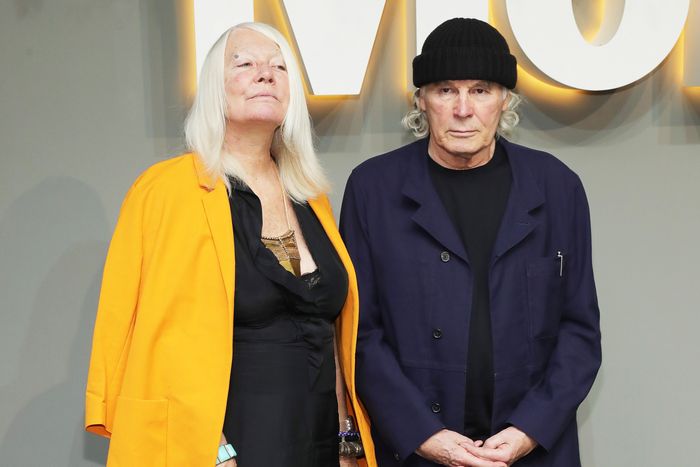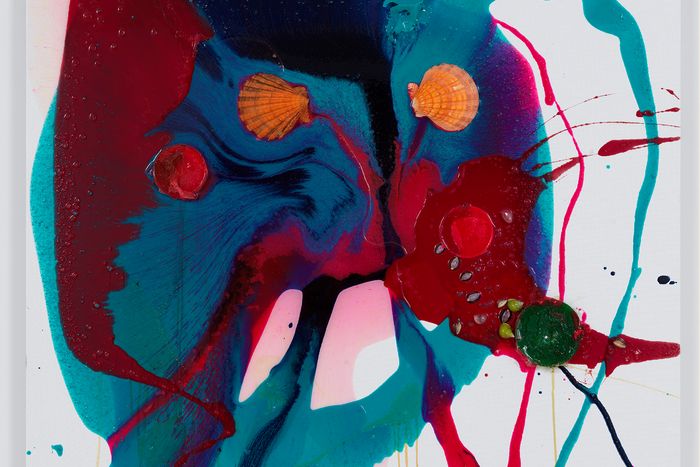
Helen Marden spent the pandemic year painting and with family, her life slowed down but not in every way a bad way. “I felt lucky,” she says, “but extremely sad.” Despite her privilege, it’s not as though she wasn’t in the viral crosshairs: She’s almost 80, and her husband of over 50 years, Brice Marden, has been stalked by cancer. A number of her friends died of COVID, including one of her closest, the architect Edward Tuttle, whom she remembers meeting on the Greek island of Hydra back in the 1970s as if it were yesterday.
“He was like 27, and I knew I was going to love him” — Helen is confident in her first impressions, as she seems at first to be in most things. “He had an Enter the Dragon T-shirt on and, I think, pearls,” she says. We’re sitting together, masked up and vaxxed up, at Gagosian’s first-floor gallery on Madison (the floors polished black, her hair Warhol white), surrounded by the lacquered tropicality of her paintings, eddies of plume-y pink, yellow, blue, and gleaming white, many shining with seashells, for an exhibition she has called “Bitter Light a Year.”
There is a hard-candy determination in the work and, one suspects, in her. Helen is a fierce and imperious globe-trotting grande dame who has known several generations of pretty much all the accomplished and interesting people worth knowing. They flock to the Mardens’ many homes: the eclectic Greenwich Village townhouse, the place on Nevis in the Caribbean, the one in Marrakech, the mini family compound upstate in Tivoli, the place they’ve had for decades on Hydra. Actually, the two, since they gave the one at the top of the hill (at some point, it was just too many stairs) to their daughters: Melia, the chef, known for the Smile, and Mirabelle, who co-owned for a time the gallery Rivington Arms, where both Dan Colen and the late Dash Snow showed (and whose Instagram currently wonders, Should I move to Athens? The city is threatening to supplant gentrified Berlin as the art-expat global catchment; in September, her father had a show at Gagosian’s gallery there). The Marden family business is the haute-bohemian hustle, and while Brice is the canonical artist, Helen is the captain of the ship. She stands up for herself — she came of age in a more blithely, brutally sexist era and taught herself, she tells me, never to be a victim — and gets what she wants. Demands it.
Although, she insists to me, she’s mellowing, getting nicer.
She made the paintings in this show upstate. “The light is beautiful in my studio,” she says. They spent most of the pandemic there with their daughters and grandchildren nearby. “It was a strange sensation for me there. I was in my studio with this amazing light thinking about all the horror.”
This particular studio was once Brice’s — he has more than one — but it’s not so easy for him to get around these days, so she commandeered it, although she’s careful to call it “their studio” and not hers. Helen is careful with him, and, to hear her tell it, he with her. He rarely gives her negative feedback on her work, for example. It has been a difficult road for her to return to painting, after all, in his considerable shadow.
In fact, Helen didn’t paint at all for many years, although painting was all she had ever wanted to do. She grew up Helen Harrington in Pennsylvania but knew from age 12 that her destiny lay elsewhere. For college, she got as far as Penn State, where she studied art; afterward, she went off to Europe and, because she had been reading Paul Bowles, Morocco. Back in New York in 1966, she got a job as a waitress at Max’s Kansas City, the now legendary high-wire hangout of artists, writers, and musicians, where, she tells me, she once decked a pushy customer. Helen was always formidable. At Max’s, “I met all these people,” she says. “I was really lucky.” It’s a word she uses often.
One of said people was a dashing young abstract painter named Brice Marden (who had previously been married to Joan Baez’s sister Pauline). Helen realized their connection was something almost mystical when she returned from a trip to the Cornish coast in 1967 to find he had painted a diptych called For Helen based on her dimensions (5 ¾ feet by 17 ¾ inches) that was the same warm pinkish-gray color as the mudflats she had described over the phone to him. They married the next year. In 1971, they visited Hydra and soon started summering there. The intense Mediterranean light seemed to invigorate Brice’s painting, and before long, his career took off.
Helen, though, withdrew from painting. “I just felt I couldn’t do it,” she says. “I didn’t have enough confidence, I guess.” They had two children, and she continued to travel. Then, in the early-1980s, with the encouragement of artist friends like Elizabeth Murray and Kiki Smith, she picked up the brushes again. There was a reason for her hesitancy: Being Brice’s wife didn’t exactly make things easy. She vividly — lividly — recalls reading Michael Kimmelman’s dismissive take on her in the Times when both she and her husband were in the 1995 Whitney Biennial, curated by Klaus Kertess; in her memory, it was “Helen is no Brice Marden.” (In fact, Kimmelman wrote, “As for including Ms. Marden, a friend of Mr. Kertess, her vigorous but clumsy abstractions don’t do her or him any favors — forget that her husband, Brice Marden, is one of the show’s pillars.”) In 2006, Brice had a retrospective at MoMA, and his paintings have become ever more celebrated and valuable (although, as Helen points out, sky-high auction prices enrich only the owners of the paintings, not the man who made them).
Meanwhile, Helen continued to make work but until recently hadn’t shown it much. She has been occupied as much as anything by running Golden Rock, the boutique resort the couple owns on Nevis (Brice has a studio there, too). Golden Rock is also the name of her active, affectionate Instagram account, where you can get updates on the entire extended clan, the family’s pet pigs, and various picturesque locales. It seems very much like a very good life, cozy and affectionate, with attractive food, interesting old furniture, and quirky headgear. (She tells me she is careful to write only positive things on Instagram — she has learned where her sharp tongue can get her.) During the pandemic, the Mardens spent a month on Nevis and rented a house in Provincetown (where most of the shells on Helen’s paintings came from; the least tropical of her works in the show was explicitly, she tells me, inspired by their front-porch tidal view). But most of the past year was spent in Tivoli, where they also own an inn, which, like Golden Rock, is more passion project than moneymaker. Helen tells me that when their friend Jann Wenner heard that, he introduced them to his money manager to try to turn things around.
This show is her second with Gagosian, which her husband joined in 2016 after many years with Matthew Marks. “Larry [Gagosian] came up to see Brice’s paintings, and Brice said, ‘Larry, she’s been painting, and you should give her a show,’” she says. “Larry looked at my painting and decided to.” She pauses, considering. “I guess that sounds not very good for women …” At the first show, Zac Posen bought one, and so did her friend Anne Bass — at least that’s her memory — but the buyer who made her happiest was Nicola Del Roscio, the late Cy Twombly’s partner of many years. “Cy and I were friends,” she says. “We knew one another from when Brice was working for [Robert] Rauschenberg.”
Yes, she has somehow been friends with everybody.
Of Helen’s current work, Gagosian’s release explains that “using resin to bind neon-bright acrylics and raw powdered pigments with natural substances and found objects, she invests the aesthetics and techniques of expressive abstraction with renewed variety and purpose.” Which is to say, the paintings aren’t trying to be aloof or obscure their particular femininity (even the shells: See Botticelli’s The Birth of Venus). In January, Helen posted a Camus quote on her IG: “In the depths of winter, I finally learned that within me there lay an invincible summer.” She could have used it as an epigraph for this show. Or, as she tells me, “I want these paintings to project joy.”
“Bitter Light a Year” is on view from April 6 to May 8 at Gagosian Gallery, 976 Madison Avenue.
"bitter" - Google News
April 17, 2021 at 12:32AM
https://ift.tt/32jZymG
Helen Marden’s Bitter, Lucky Light - Vulture
"bitter" - Google News
https://ift.tt/3bZFysT
https://ift.tt/2KSpWvj
Bagikan Berita Ini

















0 Response to "Helen Marden’s Bitter, Lucky Light - Vulture"
Post a Comment